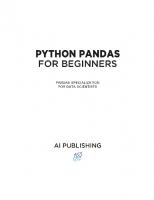PYTHON PROGRAMMING: PANDAS ACROSS EXAMPLES
Pandas is a Python package that provides fast and flexible data structures designed to make working with "relationa
286 121 10MB
English Pages 396 Year 2023
Table of contents :
Cross-section
introduction
DATA STRUCTURES IN PANDAS. WORKING WITH SERIES AND DATAFRAMES
1.1 DATA STRUCTURES: DATAFRAMES AND SERIES
1.1.1 Starting with Pandas. Data structures
1.1.2 DataFrames
1.1.3 Series
1.1.4 Methods
1.2 Reading and writing tabular data
1.3 SUBSETS OF DATA IN DATAFRAMES
1.3.1 Selection of columns of a DataFrame.
1.3.2 Selection of rows of a DataFrame.
1.3.3 Selection of specific rows and columns of a dataframe
1.4 INTRODUCTION TO VISUALISATIONS
1.5 CREATION OF DERIVED COLUMNS
1.6 CALCULATION OF SUMMARY STATISTICS
1.6.1 Summary statistics by category. Groupby() method
1.6.2 Count number of records per category. Method value_counts()
1.7 REMODELLING THE DESIGN OF TABLES
1.7.1 Sort rows of a table. sort.value() method
1.7.2 Transform long table format to wide
1.7.3 Pivot tables. Method pivot()
1.7.4 Transform table format width to length
1.8 combine data from several tables
1.8.1 Concatenate tables using a common identifier. Concat() method
1.8.2 Join tables using a common identifier. merge() method
1.9 TIME SERIES DATA
1.9.1 Date and time properties. to.datetime() method
1.9.2 Date and time as index. Method pivot()
1.9.3 Resample a time series to another frequency. Resample() method
1.10 TEXTUAL DATA: CHAINS
BASIC METHODS IN PANDAS
2.1 CREATING OBJECTS, WORKING WITH DATA AND OPERATIONS
2.1.1 Creation of objects
2.1.2 Showing data
2.1.3 Selection
2.1.4 Missing data
2.1.5 Statistical operations
2.2 Methods DATA PARATRANSFORMATION
2.2.1 Merge: concat() method
2.2.2 Merge: merge() method
2.2.3 Grouping. Groupby() method
2.2.4 Hierarchical indexing and remodelling
2.2.5 Pivot tables. Method pivot()
2.3 TIME SERIES AND CATEGORICAL DATA
2.3.1 Time series
2.3.2 Categorical data
2.4 Data representation
2.5 Data input/output
METHODS FOR DATA STRUCTURES IN PANDAS
3.1 Introduction to data structures
Cross-section
introduction
DATA STRUCTURES IN PANDAS. WORKING WITH SERIES AND DATAFRAMES
1.1 DATA STRUCTURES: DATAFRAMES AND SERIES
1.1.1 Starting with Pandas. Data structures
1.1.2 DataFrames
1.1.3 Series
1.1.4 Methods
1.2 Reading and writing tabular data
1.3 SUBSETS OF DATA IN DATAFRAMES
1.3.1 Selection of columns of a DataFrame.
1.3.2 Selection of rows of a DataFrame.
1.3.3 Selection of specific rows and columns of a dataframe
1.4 INTRODUCTION TO VISUALISATIONS
1.5 CREATION OF DERIVED COLUMNS
1.6 CALCULATION OF SUMMARY STATISTICS
1.6.1 Summary statistics by category. Groupby() method
1.6.2 Count number of records per category. Method value_counts()
1.7 REMODELLING THE DESIGN OF TABLES
1.7.1 Sort rows of a table. sort.value() method
1.7.2 Transform long table format to wide
1.7.3 Pivot tables. Method pivot()
1.7.4 Transform table format width to length
1.8 combine data from several tables
1.8.1 Concatenate tables using a common identifier. Concat() method
1.8.2 Join tables using a common identifier. merge() method
1.9 TIME SERIES DATA
1.9.1 Date and time properties. to.datetime() method
1.9.2 Date and time as index. Method pivot()
1.9.3 Resample a time series to another frequency. Resample() method
1.10 TEXTUAL DATA: CHAINS
BASIC METHODS IN PANDAS
2.1 CREATING OBJECTS, WORKING WITH DATA AND OPERATIONS
2.1.1 Creation of objects
2.1.2 Showing data
2.1.3 Selection
2.1.4 Missing data
2.1.5 Statistical operations
2.2 Methods DATA PARATRANSFORMATION
2.2.1 Merge: concat() method
2.2.2 Merge: merge() method
2.2.3 Grouping. Groupby() method
2.2.4 Hierarchical indexing and remodelling
2.2.5 Pivot tables. Method pivot()
2.3 TIME SERIES AND CATEGORICAL DATA
2.3.1 Time series
2.3.2 Categorical data
2.4 Data representation
2.5 Data input/output
METHODS FOR DATA STRUCTURES IN PANDAS
3.1 Introduction to data structures










